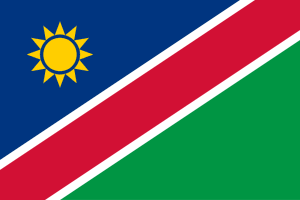
| Colors | HEX Code | RGB | CMYK |
|---|---|---|---|
| Blue | #003580 | 0, 53, 128 | 100, 59, 0, 50 |
| White | #FFFFFF | 255, 255, 255 | 0, 0, 0, 0 |
| Red | #D21034 | 210, 16, 52 | 0, 92, 75, 18 |
| Green | #009543 | 0, 149, 67 | 100, 0, 55, 42 |
| Yellow | #FFCE00 | 255, 206, 0 | 0, 19, 100, 0 |
The flag of Namibia consists of diagonal stripes of blue, red, and green, separated by white fimbriations with a golden sun in the upper hoist corner. The sun has 12 rays emitted from it. The blue and green stripes are wider than the middle red stripe.
Meaning of the Flag of Namibia
The sun symbolizes life and energy. The yellow color of the sun represents the warmth and the plains of the Namib Desert. The blue color symbolizes the sky and the Atlantic Ocean which offers Namibia its marine resources. It also represents rain and water. The red color represents the Namibian people, and their heroic struggle to achieve unity and equality for all people. White refers to peace and unity. The green color symbolizes Namibia’s vegetation and agricultural resources.
History of the Flag of Namibia
Namibia was colonized by Germany in the 19th century. Germany was defeated in WWI, and Namibia, then known as South West Africa, was under South African administration after World War I, following a League of Nations mandate. However, South Africa’s administration was deemed illegal by the United Nations, and Namibia remained under South African control until 1990 when it gained independence. As it was moving towards independence through negotiations, a competition was held to design a flag to be hoisted when announcing the new Republic named Namibia. A committee met and chose the three diagonal-stripe flag, with a yellow sun in the canton. The colors were inspired by the South West Africa People’s Organization flag. It was officially adopted in 1990 and was hoisted on Independence Day on March 21, 1990.